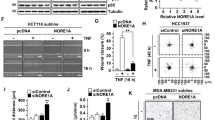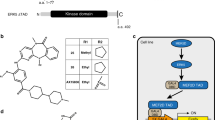Abstract
Overexpression of epidermal growth factor (EGF) receptor and constitutive activation of nuclear factor-κB (NF-κB) are frequently encountered in tumor cells. Although EGF has been shown to induce NF-κB activation, the mechanism is poorly understood. EGF activated NF-κB DNA binding, induced NF-κB reporter activity and the expression of antiapoptotic and cell-proliferative gene products. Interestingly, non-small cell lung adenocarcinoma cell lines (HCC827 and H3255), which exhibit EGFR amplification, showed ligand-independent activation of NF-κB. Unlike tumor-necrosis factor (TNF), however, EGF failed to induce IκBα phosphorylation and ubiquitination and the activation of IκBα kinase (IKK). Although DN-IKKβ inhibited TNF-induced NF-κB activity, DN-IKKβ had no effect on EGF-induced NF-κB activation, suggesting that EGF-induced NF-κB activation is IKK independent. Using dominant-negative plasmids, we also demonstrated the role of TRADD, TRAF2, NIK and Ras in EGF-induced NF-κB activation. By using specific antibodies and IκBα plasmid, which is mutated at tyrosine 42 to phenylalanine, we show that EGF induced the tyrosine phosphorylation of IκBα at residue 42. Furthermore, EGF receptor kinase inhibitor blocked IκBα phosphorylation and consequent NF-κB activation. Overall, our results indicate that tyrosine phosphorylation of IκBα at residue 42 is critical for EGF-induced NF-κB activation pathway.
This is a preview of subscription content, access via your institution
Access options
Subscribe to this journal
Receive 50 print issues and online access
$259.00 per year
only $5.18 per issue
Buy this article
- Purchase on Springer Link
- Instant access to full article PDF
Prices may be subject to local taxes which are calculated during checkout







Similar content being viewed by others
Abbreviations
- EGF:
-
epidermal growth factor
- EGFR:
-
epidermal growth factor receptor
- EMSA:
-
electrophoretic mobility shift assay
- IκB:
-
inhibitory subunit of NF-κB
- NF-κB:
-
nuclear factor-κB
References
Aggarwal BB . (2004). Nuclear factor-kappaB: the enemy within. Cancer Cell 6: 203–208.
Amann J, Kalyankrishna S, Massion PP, Ohm JE, Girard L, Shigematsu H et al. (2005). Aberrant epidermal growth factor receptor signaling and enhanced sensitivity to EGFR inhibitors in lung cancer. Cancer Res 65: 226–235.
Biswas DK, Cruz AP, Gansberger E, Pardee AB . (2000). Epidermal growth factor-induced nuclear factor kappaB activation: a major pathway of cell-cycle progression in estrogen-receptor negative breast cancer cells. Proc Natl Acad Sci USA 97: 8542–8547.
Campbell KJ, Rocha S, Perkins ND . (2004). Active repression of antiapoptotic gene expression by RelA(p65) NF-kappa B. Mol Cell 13: 853–865.
Chaturvedi MM, Mukhopadhyay A, Aggarwal BB . (2000). Assay for redox-sensitive transcription factor. Methods Enzymol 319: 585–602.
Digicaylioglu M, Lipton SA . (2001). Erythropoietin-mediated neuroprotection involves cross-talk between Jak2 and NF-kappaB signalling cascades. Nature 412: 641–647.
Fenteany G, Standaert RF, Lane WS, Choi S, Corey EJ, Schreiber SL . (1995). Inhibition of proteasome activities and subunit-specific amino-terminal threonine modification by lactacystin. Science 268: 726–731.
Finco TS, Baldwin Jr AS . (1993). kappaB site-dependent induction of gene expression by diverse inducers of nuclear factor kappaB requires Raf-1. J Biol Chem 268: 17676–17679.
Habib AA, Hognason T, Ren J, Stefansson K, Ratan RR . (1998). The epidermal growth factor receptor associates with and recruits phosphatidylinositol 3-kinase to the platelet-derived growth factor beta receptor. J Biol Chem 273: 6885–6891.
Han Y, Weinman S, Boldogh I, Walker RK, Brasier AR . (1999). Tumor necrosis factor-alpha-inducible I kappaB-alpha proteolysis mediated by cytosolic m-calpain. A mechanism parallel to the ubiquitin-proteasome pathway for nuclear factor-kappaB activation. J Biol Chem 274: 787–794.
Haussler U, von Wichert G, Schmid RM, Keller F, Schneider G . (2005). Epidermal growth factor activates nuclear factor-kappaB in human proximal tubule cells. Am J Physiol Renal Physiol 289: F808–F815.
Hsu H, Huang J, Shu HB, Baichwal V, Goeddel DV . (1996). TNF-dependent recruitment of the protein kinase RIP to the TNF receptor-1 signaling complex. Immunity 4: 387–396.
Imbert V, Rupec RA, Livolsi A, Pahl HL, Traenckner EB, Mueller-Dieckmann C et al. (1996). Tyrosine phosphorylation of I kappa B-alpha activates NF-kappaB without proteolytic degradation of I kappa B-alpha. Cell 86: 787–798.
Lynch TJ, Bell DW, Sordella R, Gurubhagavatula S, Okimoto RA, Brannigan BW et al. (2004). Activating mutations in the epidermal growth factor receptor underlying responsiveness of non-small-cell lung cancer to gefitinib. N Engl J Med 350: 2129–2139.
Malinin NL, Boldin MP, Kovalenko AV, Wallach D . (1997). MAP3K-related kinase involved in NF-kappaB induction by TNF, CD95 and IL-1. Nature 385: 540–544.
Mendelsohn J, Baselga J . (2000). The EGF receptor family as targets for cancer therapy. Oncogene 19: 6550–6565.
Mukhopadhyay A, Manna SK, Aggarwal BB . (2000). Pervanadate-induced nuclear factor-kappaB activation requires tyrosine phosphorylation and degradation of I kappaB-alpha. Comparison with tumor necrosis factor-alpha. J Biol Chem 275: 8549–8555.
Obata H, Biro S, Arima N, Kaieda H, Kihara T, Eto H et al. (1996). NF-kappaB is induced in the nuclei of cultured rat aortic smooth muscle cells by stimulation of various growth factors. Biochem Biophys Res Commun 224: 27–32.
Pawson T . (1995). Protein modules and signalling networks. Nature 373: 573–580.
Singh S, Darnay BG, Aggarwal BB . (1996). Site-specific tyrosine phosphorylation of IkappaBalpha negatively regulates its inducible phosphorylation and degradation. J Biol Chem 271: 31049–31054.
Sun L, Carpenter G . (1998). Epidermal growth factor activation of NF-kappaB is mediated through IkappaBalpha degradation and intracellular free calcium. Oncogene 16: 2095–2102.
Takada Y, Aggarwal BB . (2003). Betulinic acid suppresses carcinogen-induced NF-kappaB activation through inhibition of I kappaB alpha kinase and p65 phosphorylation: abrogation of cyclooxygenase-2 and matrix metalloprotease-9. J Immunol 171: 3278–3286.
Takada Y, Fang X, Jamaluddin MS, Boyd DD, Aggarwal BB . (2004a). Genetic deletion of glycogen synthase kinase-3beta abrogates activation of IkappaBalpha kinase, JNK, Akt, and p44/p42 MAPK but potentiates apoptosis induced by tumor necrosis factor. J Biol Chem 279: 39541–39554.
Takada Y, Khuri FR, Aggarwal BB . (2004b). Protein farnesyltransferase inhibitor (SCH 66336) abolishes NF-kappaB activation induced by various carcinogens and inflammatory stimuli leading to suppression of NF-kappaB-regulated gene expression and up-regulation of apoptosis. J Biol Chem 279: 26287–26299.
Takada Y, Mukhopadhyay A, Kundu GC, Mahabeleshwar GH, Singh S, Aggarwal BB . (2003). Hydrogen peroxide activates NF-kappaB through tyrosine phosphorylation of I kappaB alpha and serine phosphorylation of p65: evidence for the involvement of I kappaB alpha kinase and Syk protein-tyrosine kinase. J Biol Chem 278: 24233–24241.
Tracy S, Mukohara T, Hansen M, Meyerson M, Johnson BE, Janne PA . (2004). Gefitinib induces apoptosis in the EGFRL858R non-small-cell lung cancer cell line H3255. Cancer Res 64: 7241–7244.
Traxler P, Allegrini PR, Brandt R, Brueggen J, Cozens R, Fabbro D et al. (2004). AEE788: a dual family epidermal growth factor receptor/ErbB2 and vascular endothelial growth factor receptor tyrosine kinase inhibitor with antitumor and antiangiogenic activity. Cancer Res 64: 4931–4941.
van der Geer P, Hunter T, Lindberg RA . (1994). Receptor protein-tyrosine kinases and their signal transduction pathways. Annu Rev Cell Biol 10: 251–337.
Vinitsky A, Michaud C, Powers JC, Orlowski M . (1992). Inhibition of the chymotrypsin-like activity of the pituitary multicatalytic proteinase complex. Biochemistry 31: 9421–9428.
Acknowledgements
We thank Dawn Chalaire for providing valuable comments. Dr Aggarwal is the Ransom Horne Jr, Professor of Cancer Research. This work was supported by a grant from the Clayton Foundation for Research (to BBA) and National Institutes of Health PO1 grant CA91844 on lung chemoprevention (to BBA).
Author information
Authors and Affiliations
Corresponding author
Rights and permissions
About this article
Cite this article
Sethi, G., Ahn, K., Chaturvedi, M. et al. Epidermal growth factor (EGF) activates nuclear factor-κB through IκBα kinase-independent but EGF receptor-kinase dependent tyrosine 42 phosphorylation of IκBα. Oncogene 26, 7324–7332 (2007). https://doi.org/10.1038/sj.onc.1210544
Received:
Revised:
Accepted:
Published:
Issue Date:
DOI: https://doi.org/10.1038/sj.onc.1210544



